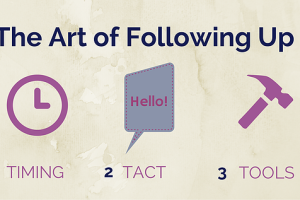This is the third of a series of posts on the importance of bringing a focused methodology to the madness that is the sales environment. In the last post, I outlined my strategy, which focuses on enhancing team selling, shortening sales cycles and closing (more) mutually beneficial deals, summarized by the acronym F.A.S.T.E.R. and examined the importance of “finding the need”.
So today, we’ll be looking at the second part of our acronym, the letter “A.”
At this point we’ve already discovered our prospect’s genuinely felt needs. The customer has an answer to the question, “Why buy anything?” but now we have to answer the next logical question on the customer’s mind: “Why buy from us?”
Here’s where we have to demonstrate that we can actually deliver a viable solution to a vexing problem, so let’s consider several things we need to keep in mind as we “articulate the solution”:
Make sure the “solution” actually solves the problem.
This may sound like an obvious statement, but it’s very important. Unless what we have for sale actually solves the problem—the whole problem—then we’re peddling gimmicks rather than formulating solutions. And we don’t get to decide the difference. The customer does.
According to consultative sales coach Linda Richardson, “The two most abused, misused, and overused words in selling are the words consultative and solution.” She observes a certain irony in this because, “without being consultative, the so-called solution is usually little more than a standard product pitch.”
That’s precisely the trap we want to avoid. We don’t want to come across as manipulative salespeople who only feign interest in their clients’ problems.
This is more difficult than it sounds, however. It’s very easy for a driven salesperson to lose perspective once a customer becomes interested in solving a problem. Even if we’ve already demonstrated a good understanding of their “pain points,” we can’t assume that prospects will immediately agree that we’re capable of delivering the best-fit solution. As a matter of fact, what we call a “solution” may, to their ears, sound like the beginning of a new set of problems we’ve failed to anticipate. If so, we’ll find ourselves in the disadvantageous position of pushing a catalog of products and services rather than articulating a “whole package” fix that clearly demonstrates where we fit in.
Our customers may listen to what we have to say, but they’ll already be strategizing about alternative ways to solve their problem. That’s why we have to apply the same customer-centric thinking to our application of a solution as we did to understanding the problem.
“When you think that your business is to solve the customer’s problem,” management consultant Peter Raulerson says, “your view shifts from being focused on your own products and services to being centered on your customer’s view of the world. Now you can [determine] the set of products and services needed by your target customers to completely satisfy their compelling reason to buy.”
The solution we propose must adequately address the “pain points,” to be sure, but it must also do so in a way that makes compelling sense for the customer all around.
Let’s remember, too, that when prospects begin weighing options, they’re going to do plenty of background research on their own.
We are not the only source of knowledge… nowadays; the buyer is in much more control and has knowledge or knows how to get it from sources unmanaged, uncontrolled and unable to be influenced by the seller.
If there is some facet of the customer’s problem that we have overlooked or left under-addressed, or if there are viable alternatives to the solution we propose altogether, then we can be sure that our customers will find out about it soon enough.
According to a 2012 Corporate Executive Board B2B study, “customers [are completing], on average, nearly 60% of a typical purchasing decision—researching solutions, ranking options, setting requirements, benchmarking pricing, and so on—before even having a conversation with a supplier.”
That means we have to make sure that what we say during the sales process jibes with what customers are able to discover on their own, amplifying their research in such a way that we can position ourselves as thought leaders whose solutions are uniquely appropriate for their needs.
We don’t want to be just one of many providers; we want to be the one that stands out in the customer’s mind.
Customize your approach.
That leads to the second thing we need to remember about solution selling: it’s not a one-size-fits-all enterprise. If we’ve done our homework on the product development side of things, we should already have offerings suitable for a variety of customer needs in our target market. But it would be a grave mistake for us to assume that our prospects will connect the dots and interpret “product flexibility” to mean “solution scalability.”
“The right mindset for solutions sales persons is to understand their client first, their company’s capabilities second, and their off-the-shelf service offerings last,” writes IT business model expert Giri Fox. “The sales person then looks at their own company through the eyes of the client and works out what’s relevant.”
Since customers’ business situations are each a little different, even within the same target market, our sales approach will need to be customized to address the very specific areas of concern that affect the individual customer we’re dealing with at the time. A canned sales pitch and boilerplate slide deck simply won’t cut it.
One of the ways we do this is by emphasizing only those product features that will generate tangible value for the customer. Stop listing every possible feature that you have – customers really don’t care unless it makes a difference to them. A feature that lacks relevance for a customer’s most pressing needs is not really a feature at all; it’s just an unnecessary complication that makes the “solution” seem overpriced. A feature that adds value, on the other hand, is one that communicates a tangible benefit to the customer’s bottom line.
A feature alone won’t necessarily make or break a sale though…
When marketing to a customer, it’s the benefits of those features that come into play. And presenting them in the right light can mean the difference between gaining and losing a customer.
The “right light” will vary from one prospect to the next, of course, but good salespeople recognize that it’s unwise to simply enumerate feature after feature during a sales presentation in the hopes that one of them will stick in the customer’s mind.
As we’re exploring a client’s “pain points,” we should be able to connect specific needs with specific features, and our presentations should major on those.
There’s a time and place for ancillary product features that differentiate what we have to sell from what our competitors are offering, of course.
These certainly should be highlighted, but before we introduce them, we need to make sure that we’ve adequately addressed the immediate problems the customer is facing.
If there are still unresolved questions in the customer’s mind about whether our solution can handle these satisfactorily, then trying to discuss additional features may come across as an attempt to draw their attention away from the real issues at stake in order to sell something the client really doesn’t need right now.
Towards the end of a sales presentation, it might be helpful to ask for feedback before moving forward: “I’d like to talk about a few other features I think you’ll be interested in hearing about, but before I do, I want to make sure that we’re on the same page so far. Is there anything we’ve covered that you’d like to know more about?”
If a prospect has major concerns at this point, then he or she is probably still working out the face value of the offering, and discussing additional features may only muddy the waters. But if things otherwise seem favorable at this point, then it’s appropriate to discuss additional features that will add new value to the proposition, perhaps by anticipating future needs or improving efficiency in other areas of operation.
Notice that even in this situation though, the focus is not on the features themselves, but on the tangible benefits that will accrue to the customer under his or her specific business circumstances.
Paint a picture.
It has been said that the best salespeople “show” rather than merely “tell.”
This is especially true when it comes to communicating value, because “valuable” is a subjective term. Our customers are more likely to perceive benefits when, instead of simply talking about them, we paint a very clear picture of what it will look like for our customers once their immediate problems are solved.
How we do this will depend on the kind of value proposition we bring to the table.
At the end of the day, most seasoned pros basically say there are 4 types:
-
Either we have the lowest price
-
The best quality for the cost
-
The most advantageous buying process
-
Or what some might call the “holy grail” of all – the ability to become an enterprise partner who takes real ownership of the customer’s outcomes.
That’s not to say that companies can’t have more than one of these factors going for them, of course; but usually one takes precedence over the others. Once we’ve zoned in on our unique value proposition, we can apply a little creativity to the communications process.
Rather than simply bragging about how we’re better priced than our competitors, for instance, we might do the math and show our prospect the hard figures on what they could save by choosing our solution over the alternatives they’re considering.
Rather than merely claiming to have features that are relevant to the customer’s needs, we might demonstrate the solution at work in a true-to-life situation based on the customer’s business environment.
If we offer a uniquely hassle-free online buying experience, the perhaps we should transact a purchase right there in the client’s office. Phrases like “easy to use” take on a lot more persuasive power, after all, when the client actually sees a desirable result materialize before his or her eyes.
We can also use “what we find” examples drawn from the experiences of other clients who have successfully overcome similar problems using our solutions in the past. Such stories, artfully placed, can lend tremendous credibility to our proposals.
This is why storytelling skills are vital for the salesperson’s toolbox.
Stories draw listeners in and hold their attention, creating suspense and heightening the impact of a satisfying resolution. Stories are not merely informative; they are entertaining and highly memorable. Delivered appropriately, they have a beginning, middle, and an end—a protagonist who encounters an obstacle and overcomes it.
Effective salespeople know how to make their prospective customers the protagonists in stories that paint a picture of how they might use a particular solution to overcome one of the most vexing problems they face in doing business.
Not everyone is a gifted storyteller, but it’s a skill that can be improved over time with practice. A wise salesperson makes it a point to file away memorable customer experience “tidbits” so that when the appropriate time comes, he or she is prepared to talk about actual applications of the solutions he or she is describing to new customers.
If we’re mindful of these three pieces of advice above, then we’ll find that we can truly articulate the best solution to our customers’ problems.
We won’t be stuck delivering canned sales pitches or rehearsing laundry lists of product features.
We won’t come across as though what we have to offer is just some flashy, shot-in-the-dark option for the customer, nor will our solution communicate its value so poorly that customers will suspect that they’re overbuying for their needs (or overpaying for what they’re actually getting).
On the contrary, they’ll see a clear connection between the product’s features and their specific requirements, and they’ll understand why it makes sense to buy from us and not from someone else.
If we’re not careful at this point, however, motivation to solve the problem can wane and the sale may never materialize. That’s why, once a prospect is favorably inclined toward our solution, the salesperson’s task is to “spark a fire” and convince the right people that now is the time to buy. We’ll talk more about this next time.








